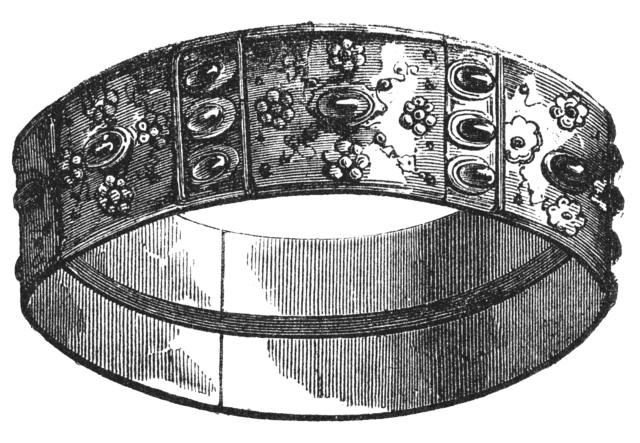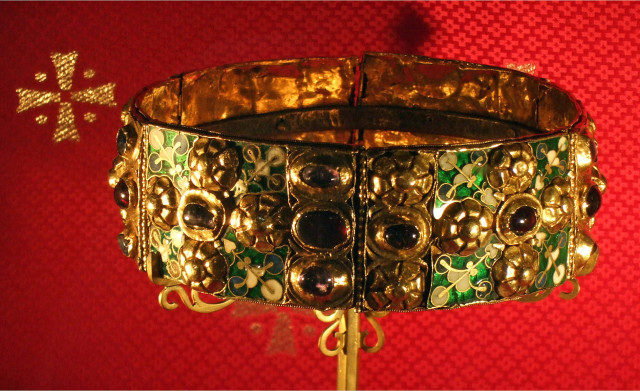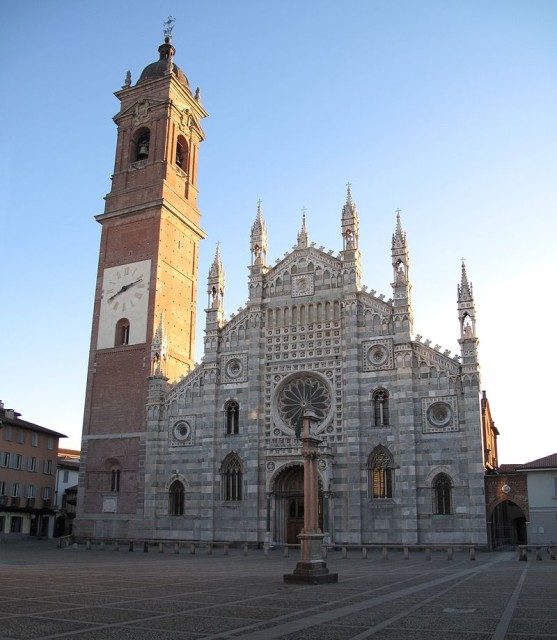In the Cathedral of Monza, located in the Lombardia (Lombardy) region in northern Italy, one of the most important relics of the Christian faith is conserved. The Cathedral itself, built in 595 by Lombard queen Theodelinda, enlarged in 1390 and again in 1606, saw the crowning of Holy Roman Emperors as well as Napoleon. The assassination of King Umberto I of Italy in 1900 in Monza initiated the church to add on a memorial chapel.
The Iron Crown of Lombardy (Corona Ferrea Langobardiae in Latin) is made of six square plates of hammered gold held together by hinges and an inner reinforcement band around the middle of the inside, and is believed to have come from the early Byzantine era 330-171 A.D. The small size of the object suggests it may have been used as an armband or as a votive crown – a small crown usually hung from decorative chains near the altar.

The crown was used for the coronation of Henry VII when he was declared Holy Roman Emperor in 1312. Not to be confused with Henry VII of England’s Tudor Dynasty in the 1500s, this Italian Henry VII lived from 1269 to 1313. It was last used in the coronation of Ferdinand I in 1558 upon his ascension to the throne of The Holy Roman Emperor.
The crown is richly decorated with seven red garnets, seven blue sapphires, four amethysts, four glass gems, gold rosettes and crosses, twenty-four enamel plates and supposedly has one of the nails used in Christ’s crucifixion incorporated into its design.

Allegedly, the nail was given to Emperor Constantine I by his mother St. Helena, who claimed to have found the true cross on which Christ hung in Jerusalem. Legend says one nail was fashioned into a bit for the horse of Constantine, now preserved in Milan, one nail was thrown into the Adriatic Sea to quiet a storm and another was used in Constantine’s war helmet. The final nail was incorporated into the Iron Crown according to Socrates.
Some say Theodelinda, the queen of the Lombards in the late 6th century was the original owner of the crown and donated it to the church in 628.
Other legends claim that Theodoric the Great, who reigned over Italy from 493 to 526, claimed it as spoils of war prize.

The Congregation of Relics at Rome in 1717 argued about whether or not a Holy nail was used in the construction of the crown but never came to a definitive conclusion. It was, however, approved for use in church ceremonies as an official Christian relic.
Reinhold N. Elze offered his hypothesis that Gisela, the daughter of Emperor Louis the Pious, King of Aquitaine and son of Charlemagne, was the original owner of the crown and upon her death in 874 she bequeathed it to her son Berengar I, a benefactor of the Cathedral of Monza.
In 1805 Napoleon crowned himself King of Italy using the Iron Crown of Lombardy proclaiming, “ieu me la donne, gare à qui la touche – God gives it to me, beware whoever touches it”. He also created the Order of the Iron Crown which was re-instituted by Austrian Emperor Francis I on January 1, 1816, after Napoleon’s fall from grace and banishment to the island of Elba in 1814.
It is believed that Antellotto Bracciforte, who restored the crown in 1345, is the person that installed the silver reinforcement band to keep the crown intact because of the broken hinges.
The Catholic Encyclopedia tells us that over thirty supposedly true nails from the cross have been produced and the Church places minimal authenticity on these claims as it has never been conclusively proven how many nails, three or four, were used in the Crucifixion, with the matter still under debate.
The crown was referred to in chapter 37 of Herman Melville’s Moby Dick where Captain Ahab imagines himself to be installed as king of Italy using the Iron Crown of Lombardy.

In 1993 the University of Milan, in Italy, performed a scientific analysis of the crown using x-rays and radiocarbon dating, and found it contained no iron and the reinforcement band was silver. The Roman Ceremonial of 1159 claimed that the iron from the nail was used to create an arch over the dome of the crown, but the arch has since disappeared.
It is doubtful that a nail from the True Cross was used in the creation of the Iron Crown of Lombardy, but the crown is still considered to be one of the most significant Holy relics and one of the most important symbols of the former Kingdom of Italy.
